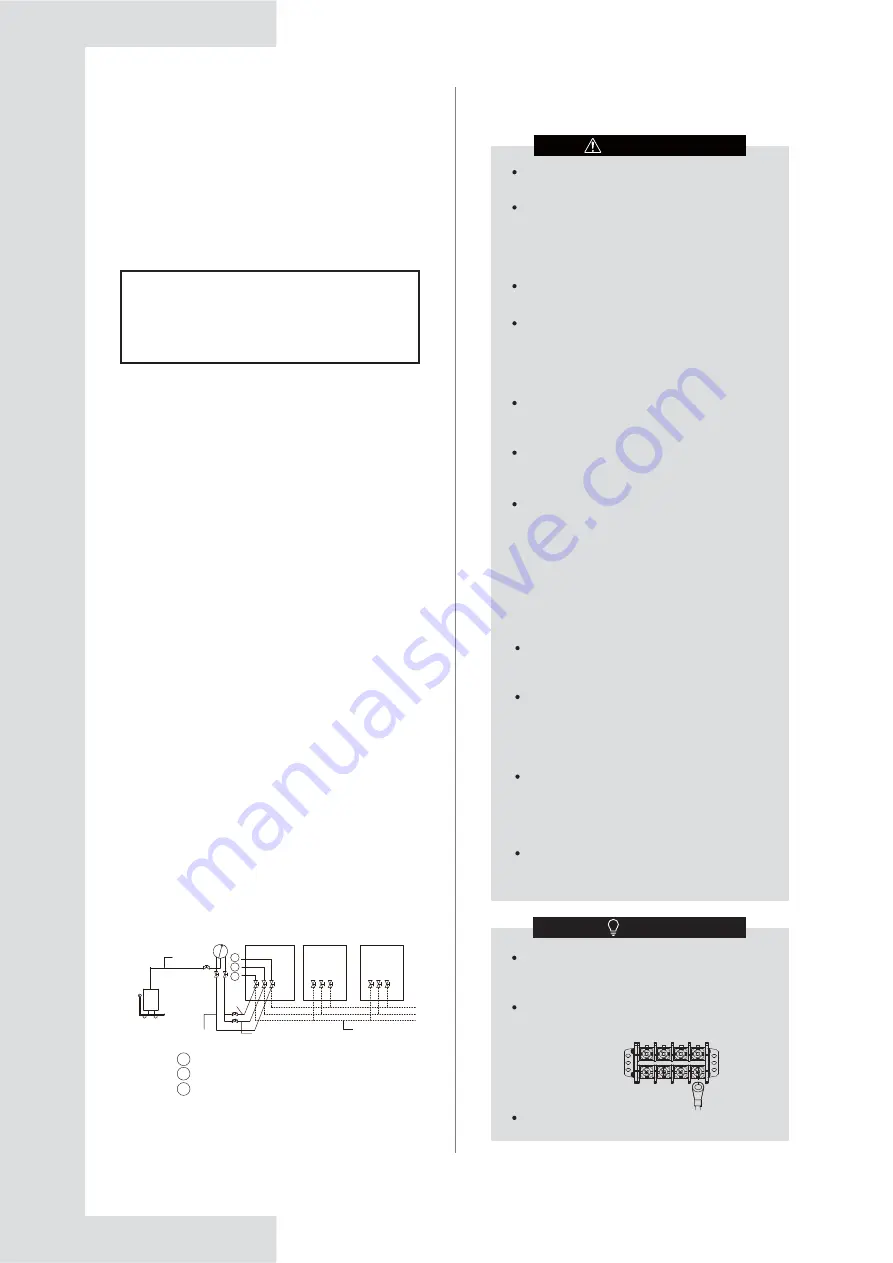
Total additional refrigerant charge amount (R) is
equal to the sum of R1, R2 and R3, calculate the
amount of refrigerant to be charged according to the
formula below:
R (kg) = R1 + R2 +R3.
Fig. 5-19
Master unit
Slave unit
Slave unit
Note: The additional refrigerant charge amount (R3) is
obtained by summing the additional charge
requirements for each of the outdoor and indoor liquid
pipes, as in the following formula, where L1 to L8
represent the equivalent lengths of the pipes of different
diameters. Assume 0.5 m for the equivalent pipe length
of each branch joint.
#*$###%£
|` ¤
_` ¤ `{
{ ¤
+`_¤{
`_¤ |
|
¤|
{ `+¤`
X X|¤
0.680
The procedure for adding refrigerant is as follows:
1. Calculate additional refrigerant charge R (kg).
2. Place a tank of R410A refrigerant on a weighing
scale. Turn the tank upside down to ensure refrigerant
is charged in a liquid state. (R410A is a blend of two
different chemicals compounds. Charging gaseous
R410A into the system could mean that the refrigerant
charged is not the correct composition).
3. After vacuum drying, the manifold should still be
connected to the master unit stop valves.
4. Connect the manifold from the pressure gauge to the
R410A refrigerant tank.
5. Open the valve where the hose (hose a) meet the
pressure gauge, and open the refrigerant tank slightly
to let the refrigerant eliminate the air.
Caution: open the tank slowly to avoid freezing your
hand.
6. Set the weighing scale to zero.
7. Open the manifold valves to begin charging
refrigerant.
8. When the amount charged reaches R (kg), close the
manifold valves. If the amount charged has not
reached R (kg) but no additional refrigerant can be
charged, close the manifold valves, run the outdoor
units in cooling mode, and then open the manifold
valve A
,
C and D. Continue charging from the service
port of low pressure stop valve until the full R (kg) of
refrigerant has been charged, then close the manifold
valve A
,
C and D. Note: Before running the system, be
sure to complete all the pre-commissioning checks and
be sure to open all stop valves as running the system
with the stop valves closed would damage the
compressor.
A
B C
D
E
3
2
1 Low pressure gas pipe stop valve
High pressure gas pipe stop valve
Liquid pipe stop valve
Pressure gauge
Hose a
Hose d
Hose c
Hose b
Field piping
Weighing scale
R410A
refrigerant tank
3
2
1
WARNING
5.10 Electrical Wiring
5.10.1 Electrical wiring precautions
Take note of the risk of electric shocks during
installation.
All the electric wires and components must
be installed by an installation personnel with
the proper electrician certification, and the
installation process must comply with the
applicable regulations.
Use only wires with copper cores for the
connections.
A main switch or safety device that can
disconnect all polarities must be installed,
and the switching device can be completely
disconnected when the corresponding
excessive voltage situation arises.
Wiring must be carried out in strict
accordance with what is stated in the product
nameplate.
Do not squeeze or pull the unit connection,
and make sure the wiring is not in contact
with the sharp edges of the sheet metal.
Make sure the grounding connection is safe
and reliable. Do not connect the earth wire to
public pipes, telephone earth wires, surge
absorbers and other places that are not
designed for grounding. Improper grounding
may cause electric shock.
Make sure the fuses and circuit breakers
installed meet the corresponding
specifications.
Make sure an electric leakage protection
device is installed to prevent electric shocks
or fires.
The model specifications and characteristics
(anti high-frequency noise characteristics) of
the electric leakage protection device are
compatible with the unit to prevent frequent
tripping.
Before power on, make sure the connections
between the power cord and terminals of the
components are secure, and the metallic
cover of the electric control box is closed
tightly.
WARNING
If HT hydro module connects to the system,
please refer to the installation manual of the HT
hydro module.
If the power supply lacks N phase or there is
an error in the N phase, the device will
malfunction.
The N phase must connect to mark N of the
terminal block, or the device will malfunction.
Do not share the same power supply line with
other devices.
NOTE
/
/
/
1
1
25






























